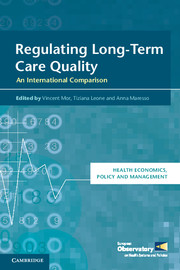Book contents
- Frontmatter
- Contents
- List of Tables, figures and boxes
- List of Contributors
- Foreword
- Part I Introduction
- Part II Long-term care quality systems based on ‘professionalism’
- Part III Long-term care quality systems based on regulatory inspection frameworks
- Part IV Long-term care quality systems based on data measurement and public reporting
- Part V Long-term care quality systems and developing regulatory systems
- Part VI Conclusion
- 16 Regulating quality of long-term care – what have we learned?
- Index
- References
16 - Regulating quality of long-term care – what have we learned?
Published online by Cambridge University Press: 05 February 2014
- Frontmatter
- Contents
- List of Tables, figures and boxes
- List of Contributors
- Foreword
- Part I Introduction
- Part II Long-term care quality systems based on ‘professionalism’
- Part III Long-term care quality systems based on regulatory inspection frameworks
- Part IV Long-term care quality systems based on data measurement and public reporting
- Part V Long-term care quality systems and developing regulatory systems
- Part VI Conclusion
- 16 Regulating quality of long-term care – what have we learned?
- Index
- References
Summary
Introduction
In this chapter we summarize key findings from the fourteen case studies, following the themes set out in Chapter 1. In particular, we aim to highlight features of the regulatory functions operating in each country, namely what type of long-term care regulatory system is in place (e.g., data-oriented or professionally oriented), its level of centralization or decentralization and, most importantly, whether any information on quality is collected and, if so, how it is used in efforts to assure and improve long-term care quality.
Long-term care regulatory approaches
The variation in approach to long-term care quality regulation characterized in the chapters of this book makes it very challenging to develop a coherent yet concise system to classify the different approaches that countries have adopted. We have attempted to classify the countries by broad regulatory approach (Table 16.1) based on the general characteristics that they share. We understand that the classifications may not be a ‘snug’ fit for each of the different systems we’ve proposed. However, the classification scheme offers a reasonably close account of the streams of regulations and quality assurance processes found in the countries represented in this book. One of the most striking things to emerge from our comparative work is that the Austrian, German, Japanese and Swiss approaches to specifying the educational levels, training and even staff certification requirements for their long-term care workforces underpins the regulatory framework operating in these countries. From our perspective, these governments cede the main responsibility for upholding standards to professional and/or provider organizations. Government sees itself as a partner in assuring quality. >This approach is quite distinct from that of the more empirical, inspection-based approaches in place in Australia, England, the Netherlands and Spain, which focus much more on government authorities monitoring providers’ compliance with statutorily defined regulations. It is even more different from the inspection-oriented systems in countries that have added a data-intensive quality measurement and public reporting approach, as is in place in Canada, Finland, New Zealand and the US. With their relatively newer long-term care systems, we’ve classified South Korea and China as having ‘developing’ regulatory approaches. Time will tell whether they will more naturally fall into any of the other three broad categories that we have created to classify the different approaches countries have adopted.
- Type
- Chapter
- Information
- Regulating Long-Term Care QualityAn International Comparison, pp. 447 - 476Publisher: Cambridge University PressPrint publication year: 2014
References
- 2
- Cited by

